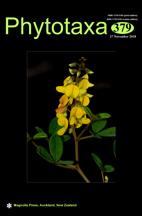Abstract
The genus Opuntia Miller (1754) (Cactaceae Juss., Opuntioideae K.Schum., Opuntieae DC.) is native to the Americas, where is distributed from southern Argentina to Canada (Anderson 2001), and represents one of the largest genus of Cactaceae with ca. 150 species (see e.g., Stuppy 2002). Members of Opuntia shares a combination of peculiar morphological traits, including shrubs or trees with flattened photosynthetic stem shoots (cladodes), areoles with large smooth or retrorsely barbed spines and glochids, reduced and small caducous leaves , rotaceous diurnal flowers with inferior ovaries inner the pericarpels and stigma plurilobed, stamens with thigmonasty, reticulate semitectate pollen, and seeds covered by a sclerified funicular aril (Buxbaum 1953, Anderson 2001, Stuppy 2002, Hunt 2006, Majure & Puente 2014, Majure et al. 2017).

